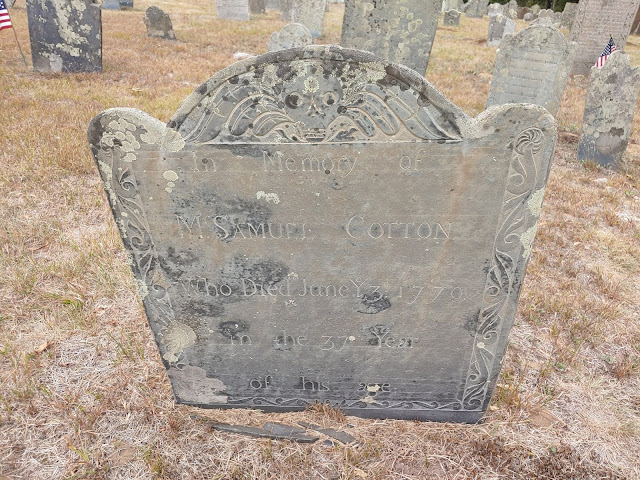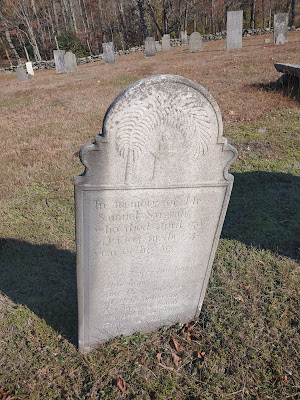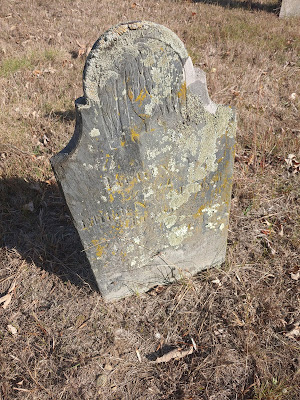The stone of Martha Storrs dated 1728, a fine example of
Obadiah Wheeler's early work. Notice the misspellings
At this time, english was often considered fluid, and the
spelling of December as "Dsembe" was more likely to
have been used so it would fit on the stone.
The stone of Reverend Eldezer Williams, dated 1742 is another example of Wheeler's fine
craftsmanship. He developed several variants of tombstones by the 1730s, all very detailed
with different symbols and borders.
Another variant of Wheelers work dated 1736. Wheeler often
used hexfoil rosettes on his stone borders, a symbol of mortality
that has been used on tombstones for over two thousand years.
More Wheeler stones in a bit,
Josiah Manning is well represented here, with 79 stones present, by far the most common carver in the yard.
An example of Josiah Mannings early style.
His early work consisted of batlike wings, and clovers,
clearly influenced by Gershom Bartlett as seen
by the borders, and rosettes.
The Coffin stone on the left, dated 1768 is one of the few non
winged soul designs Manning carved. The stone on the right dated
1765, is probably backdated, likely placed at the same time
as the Coffin stone.
Another "bat wing" style Manning stone dated 1770.
the diamond shape is also only present on a rare
few early Manning stones.
An elaborate Manning stone dated 1778,
note the scaled wings, sometimes used
on more elaborate stones, and the crisp
border binding.
More Manning stones in a bit, but first a big surprise.
Elijah Sikes was a carver in the later 1700s who's stones are common in much of Northeastern CT especially in Pomfret, Brooklyn, Thompson, and others as well as in some parts of southern Mass east of the CT river. While an occasional stone was placed as far south as Lebanon or Griswold, they are very rare south Brooklyn with the exception of Plainfield. A single Sikes stone is in the Olde Center Cemetery,
and even more interesting is it being an expensive Marble stone, while Sikes usually carved on unique stone material with a high amount of iron oxide.
The stone for David Adams dated 1790, is a rare example of Elijah Sikes
work on marble. It is the only Sikes stone in the yard.
Another common carver in the very early 1700s was John Hartshorne. Hartshorne was born in 1650 and originally lived in Rowly Mass and served in the King Phillips War. He was the regions first grave carver, starting in the 1680's. Around 1712 he moved to Franklin CT and continued carving tombstones until when he died in 1737 aged 88. 19 of his stones can be found in the Olde Center Cemetery.
One example of his work on the stone of Capt. William Hall, dated
1727. Notice the abstract borders, and rosettes.
Another example of his work, dated 1728. The blank
staring face is certainly a focal point on his work.
The grave of Mary Wood dated 1727. Notice the
different border pattern and rosettes compared to
the first one. His designs often varied greatly.
A large tombstone carved by Gershom Bartlett. Notice
the lobed wings compared to the usual elongated style.
Another stone by Bartlett, dated 1755. Notice the clovers and borders,
an inspiration to the early work of Josiah Manning. I always liked the
almost perfectly round face on this stone.
Another lobed winged Bartlett stone dated 1766.
A total of 7 stones by Bartlett are in the yard.
Another surprise was finding two dark slate stones in the yard. These stones were carved by a Killingly carver named Stephen Spalding. Unlike most regional carvers, Spaulding outsourced his material in favor of black/blue slate a more expensive and desirable stone then the common Schist. His stones are somewhat common in the Killingy/Pomfret/Brooklyn region though as seen here are spread out in small numbers. Two are present in this graveyard.
One stone dated 1796 for Booz Stearns aged 96. This stone
is in need of a deep clean, as it is in great shape and is a
somewhat rare example of his work.
Another one of Spauldings headstones Dated 1789.
The only other traditional slate was this "Deaths Head" Winged Skull stone
dated 1763, imported from the tombstone mecca of Boston. Skull designs are very
rare in Connecticut graveyards, with only a handful of regional carvers ever using them
on their stones notably Thomas Johnson. Some cemeteries in Connecticut port towns
have a high number of these Boston made stones due to the easier method of importation
via ship, some examples include yards in New London, Old Saybrook, and Milford.
Another surprise was my first sighting of the "Hampton Indian Carver", an unknown carver out of Hampton who carved stones in some surrounding yards including one here.
This stone dated 1766 features an abstract effigy shows what looks like a large nosed figure with a headdress of feathers. The carving designs seem to be influenced by Benjamin Collins, note the segmented lines and hexfoil rosettes. Stone for Eunice Martha aged 73.
The Collins Family carvers are represented here, two stones from Benjamin and four from Zerubabel.
This Benjamin Collins tombstone dated 1743 is a very well
preserved example of his work.
This stone for John Storrs is a fine example of
Zerubabel Collins early work.
Another stone by Zerubabel, backdated at 1746, would actually have been carved in the mid 1750s to early 1760s based on design tropes.
The stone marking the grave of Esther Barrow, carved by Jonathan Loomis
of Coventry dated 1761. Note the Gershom Bartlett influence on the wings.
Another stone by Loomis dated 1770. Loomis had many variations
of designs on his sones, notice the 3 lobed wings, vine borders and
Wheeler style Hexigrams not to mention stone shape as compared
to the one above. 3 stones carved by Johnathan Loomis are in the
Olde Mansfield Center Cemetery.
A single stone carved by Lebanon carver John Huntington is
present in this cemetery, dated 1765.
A beautiful winged soul marble stone for Rezolved Stevens dated
1792. Carver unknown. Possibly imported from Vermont where
marble was a common stone for grave making.
Crude fieldstone marked "E.H Dyed Febuary 19th 1721 aged 26.
This being the oldest surviving stone in the yard.
Now for some more awaited Obadiah Wheeler stones.
This stone dated 1722, is the oldest Wheeler stone
in this cemetery. The material however is not schist
but appears to be some form of local soapstone.
This stone dated 1732 is another varient of Wheelers stylings. Notice the sphere designs on the borders, and comma shaped symbols mixed in. Wheeler was very imaginative in his carving work.
The stone of Hannah Williams dated 1742, is another example of a 3d carved face by Wheeler, also notice the heart under the face, hexfoils, and abstract symbols underneath the epitaph. This stone was featured in the book "The Colonial Burying Grounds of Eastern CT and the men who made them" by James A Slater.
Another Wheeler stone dated 1733. By the early 1730s he began using
closed eyes on his stones, though still used open eyes on others.
Another earlier Wheeler stone, dated 1727. Borders resemble some used by John
Hartshorne. Around 10 Wheeler stones are in this yard.
Besides some great examples of Mannings early work, many higher quality expensive Manning stones are viewable here.
One of the premium Manning stones, about 6 feet tall dated 1784. Manning
would often use elaborate borders and shapes on his more expensive work.
Another example of Mannings early bat wing style on this stone dated 1770.
Another elaborate Manning stone dated 1775.
Stone dated 1795 possibly carved by Josiahs son Rockwell due to the mouth and
eyes alignment. Josiah was working with with his sons Fredrick and Rockwell
in the grave carving trade by the mid 1780s , and usually their stones are
impossible to tell apart.
An odd Manning sandstone dated 1762 though certainly backdated. Manning seemed to havefound a source of very pure sandstone in the late 1770s and used it to make stones from the later
1770's to the late 1780's, though still predominantly using schist. Many of these stones are
viewable in the old Norwichtown Burying ground, though only one was here in Mansfield.
Elegant Manning stone dated 1786.
An example of a more standard Manning
stone, dated 1802.
Row of stones carved by Obadiah Wheeler. The carving dates are chronological so one can view the progression in his designs and stylistic elements.
Mix of the premium Manning manning stones.
View of the center of the Cemetery. Stones carved by Gershom Bartlett and Josiah Manning are visible, plus a Brownstone table style grave.
A few stones from Aaron Hasking and the Upswept Wing Carver were also present though I did not get a chance to get any photos of them at the time. The latest Soul effigy stone here was carved in 1807.
Post Colonial style stones.
A single portland brownstone headstone
was in the yard, dated 1802.
A Schist urn stone dated 1816. Note the more
traditional shape of the stone. Schist was still
a common grave making material in the region
despite the increasing popularity of marble
until the mid 1820s.
Interesting Schist stone dated 1810, the polished
appearance of these is abnormal for stones of
this era.
Marble urn and willow stone dated 1804.
Schist stone dated 1810.
Schist Urn and Willow stone dated 1816.
A single urn and willow type slate dated 1824, likely imported from
Rhode Island based on design.
Marble slab stone dated 1814 with Urn and
Willow and pillar column designs. Reminds
me of some designs used on Boston
slates of the same era.
Hope you all enjoyed!































































































